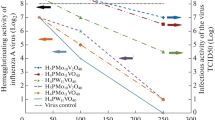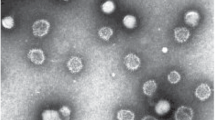Summary
A neutral proteasea, which was extracted from rat ascites hepatoma cells and then purified by chromatography using TEAE-cellulose followed by hydroxyapatite (eluted in 0.12 M phosphate buffer), induced an electron microscopic alteration (disruption) of tight junctions resulting in a dissociation of the close contact in the apical portion of the cell islands, but simple apposition, intermediate junctions and desmosomes in the close contact in the inner portion of the cell islands remained intact. On the other hand, ethylenediamine tetraacetate (EDTA), as previously described, induced an electron microscopic alteration of simple apposition, intermediate junctions and desmosomes resulting in a dissociation of the close contact in the inner portion of the cell islands, but tight junctions remained unchanged, Thus, the protease could provoke a complete microscopic dissociation of the cells in the presence of EDTA. A similar complete dissociation of the cells, under calcium-depleted conditions, was also provoked by a factor (of peptide nature) capable of activating and releasing the protease in and from the cells, which was isolated from tumor tissue. In contrast, no or little dissociation of the cells was induced by a neutral proteaseb in the presence of EDTA. This protease was extracted from the cells and eluted in 0.1 M phosphate buffer on hydroxyapatite described above. It was therefore assumed that such tumor cell dissociation may be associated with the combined conditions of activation of a certain neutral protease and calcium depletion.
Similar content being viewed by others
References
Carruthers, C., Suntzeff, V.: The role of calcium in carcinogenesis. Science (N.Y.)99, 245–247 (1944)
Coman, D.R.: Decreased mutual adhesiveness, a property of cells from squamous cell carcinomas. Cancer Res.4, 625–629 (1944)
Delong, R.P., Coman, D.R., Zeidman, I.: The significance of low calcium and high potassium content in neoplastic tissue. Cancer (N.Y.)3, 718–721 (1950)
Hayashi, H., Miyoshi, H., Nitta, R., Udaka, K.: Proteolytic mechanism in recurrence of Arthus-type inflammation by thiol compounds. Br. J. Exp. Path.43, 564–573 (1962)
Hayashi, H., Yoshida, K., Ozaki, T., Ushijima, K.: Chemotactic factor associated with invasion of cancer cells. Nature (Lond.)226, 1174–1175 (1970)
Ishihara, H., Ishimaru, Y., Hayashi, H.: Ultrastructural changes of intercellular junctions in rat ascites hepatoma cells with calcium depletion. Br. J. Cancer35, 643–656 (1977)
Ishimaru, Y., Ishihara, H., Hayashi, H.: An electron microscopic study of tumor cell adhesiveness induced by aggregation promoting factor from rat ascites hepatoma cells. Br. J. Cancer31, 207–217 (1975)
Koono, M., Hayashi, H.: Purification of inflammatory SH-dependent proteases I and II from Arthus skin lesion and their significance in inflammatory changes. Jap. J. Biochem. Soc.41, 436 (1969)
Koono, M., Katsuya, H., Hayashi, H.: Studies on the mechanisms of invasion in cancer. IV. A factor associated with release of neutral protease of tumor cell. Int. J. Cancer13, 334–342 (1974a)
Koono, M., Ushijima, K., Hayashi, H.: Studies on the mechanisms of invasion in cancer. III. Purification of a neutral protease of rat ascites hepatoma cell associated with production of chemotactic factor for cancer cells. Int. J. Cancer13, 105–115 (1974b)
Kunitz, M.: Crystalline soybean trypsin inhibitor. II. General properties. J. Gen. Physiol.30, 291–310 (1947)
McCutheon, M., Coman, D.R., Moore, F.B.: Studies on invasiveness of cancer. Adhesiveness of malignant cells in various human adenocarcinomas. Cancer1, 460–467 (1948)
Ozaki, T., Yoshida, K., Ushijima, K., Hayashi, H.: Studies on the mechanisms of invasion in cancer. II. In vivo effects of a factor chemotactic for cancer cells. Int. J. Cancer7, 93–100 (1971)
Sedar, A.W., Forte, J.G.: Effects of calcium depletion on the junctional complex between oxyntic cells of gastric glands. J. Cell Biol.22, 173–188 (1964)
Staehelin, L.A.: Further observations on the fine structure of freeze-cleaved tight junctions. J. Cell Sci.13, 763–786 (1973)
Ushijima, K., Nishi, H., Ishikura, A., Hayashi, H.: Characterization of two different factors chemotactic for cancer cells from tumor tissue. Virchows Arch. B Cell Path.21, 119–131 (1976)
Yoshida, K., Ozaki, T., Ushijima, K., Hayashi, H.: Studies on the mechanisms of invasion in cancer. I. Isolation and purification of a factor chemotactic for cancer cells. Int. J. Cancer6, 123–132 (1970)
Author information
Authors and Affiliations
Additional information
This is No. 7 of the studies on the mechanisms of invasion in cancer
Rights and permissions
About this article
Cite this article
Katsuya, H., Ishimaru, Y., Koono, M. et al. A light and electron microscopic study on complete dissociation of rat ascites hepatoma cells under activation of neutral protease and calcium depletion. Virchows Arch. B Cell Path. 27, 159–172 (1978). https://doi.org/10.1007/BF02888991
Received:
Issue Date:
DOI: https://doi.org/10.1007/BF02888991




